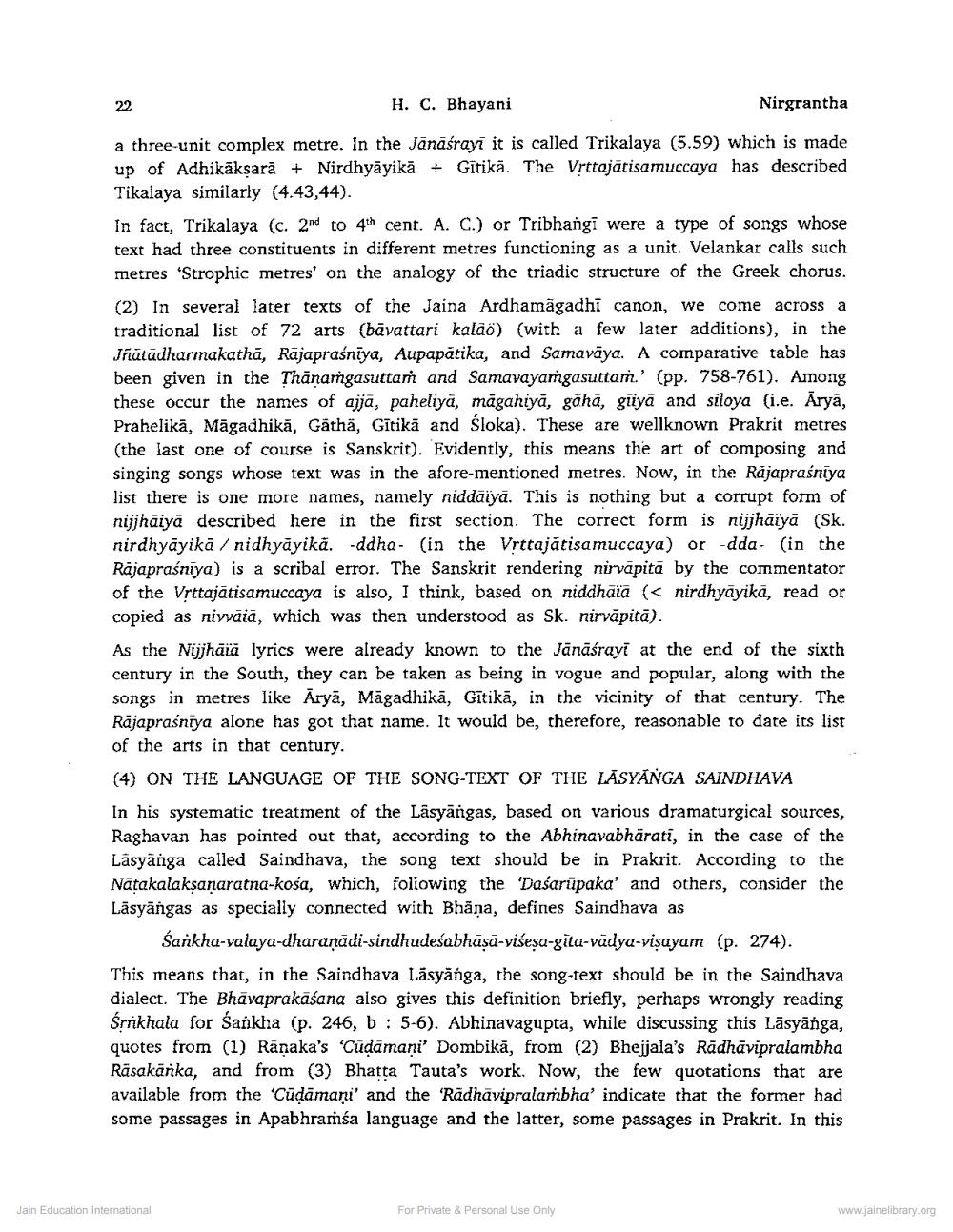Book Title: MIA Miscellany Author(s): H C Bhayani Publisher: Z_Nirgrantha_1_022701.pdf and Nirgrantha_2_022702.pdf and Nirgrantha_3_022703.pdf View full book textPage 5
________________ H. C. Bhayani Nirgrantha a three-unit complex metre. In the Jānāśrayī it is called Trikalaya (5.59) which is made up of Adhikāksarā + Nirdhyāyikā + Gitikā. The Vrttajātisamuccaya has described Tikalaya similarly (4.43,44). In fact, Trikalaya (c. 2nd to 4th cent. A. C.) or Tribhangi were a type of songs whose text had three constituents in different metres functioning as a unit. Velankar calls such metres 'Strophic metres' on the analogy of the triadic structure of the Greek chorus. (2) In several later texts of the Jaina Ardhamāgadhi canon, we come across a traditional list of 72 arts (bavattari kalão) (with a few later additions), in the Jnātādharmakathā, Rajapraśniya, Aupapătika, and Samavāya. A comparative table has been given in the Thānamgasuttaṁ and Samavayamgasuttam.' (pp. 758-761). Among these occur the names of ajja, paheliyä, māgahiyā, gāhā, giyā and siloya (i.e. Āryä, Prahelikā, Māgadhikā, Gäthä, Gītikā and śloka). These are wellknown Prakrit metres (the last one of course is Sanskrit). Evidently, this means the art of composing and singing songs whose text was in the afore-mentioned metres. Now, in the Rajapraśniya list there is one more names, namely niddaiya. This is nothing but a corrupt form of nijjhāiya described here in the first section. The correct form is nijjhaiya (Sk. nirdhyāyikā / nidhyāyikā. -ddha- (in the Vrttajatisamuccaya) or -dda. (in the Rajapraśniya) is a scribal error. The Sanskrit rendering nirvāpitā by the commentator of the Vrttajātisamuccaya is also, I think, based on niddhaia (< nirdhyāyikā, read or copied as niyvaia, which was then understood as Sk. nirvāpitā). As the Nijjhāiä lyrics were already known to the Jānāśrayi at the end of the sixth century in the South, they can be taken as being in vogue and popular, along with the songs in metres like Āryā, Māgadhikā, Gītikā, in the vicinity of that century. The Rājapraśniya alone has got that name. It would be, therefore, reasonable to date its list of the arts in that century. (4) ON THE LANGUAGE OF THE SONG-TEXT OF THE LĀSYANGA SAINDHAVA In his systematic treatment of the Lāsyāngas, based on various dramaturgical sources, Raghavan has pointed out that, according to the Abhinavabhārati, in the case of the Lāsyanga called Saindhava, the song text should be in Prakrit. According to the Natakalaksaņaratna-kosa, which, following the 'Dasarūpaka' and others, consider the Lāsyāngas as specially connected with Bhãņa, defines Saindhava as Sankha-valaya-dharanādi-sindhudeśabhasa-visesa-gita-vädya-visayam (p. 274). This means that, in the Saindhava Lāsyānga, the song-text should be in the Saindhava dialect. The Bhāvaprakāśana also gives this definition briefly, perhaps wrongly reading śrrikhala for Sankha (p. 246, b: 5-6). Abhinavagupta, while discussing this Lāsyānga, quotes from (1) Rānaka's 'Cudamani' Dombikā, from (2) Bhejjala's Rādhāvipralambha Rāsakārka, and from (3) Bhatta Tauta's work. Now, the few quotations that are available from the 'Cūdāmaņi' and the "Rādhavipralambha' indicate that the former had some passages in Apabhramśa language and the latter, some passages in Prakrit. In this Jain Education International For Private & Personal Use Only www.jainelibrary.orgPage Navigation
1 ... 3 4 5 6 7 8
